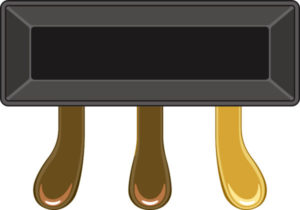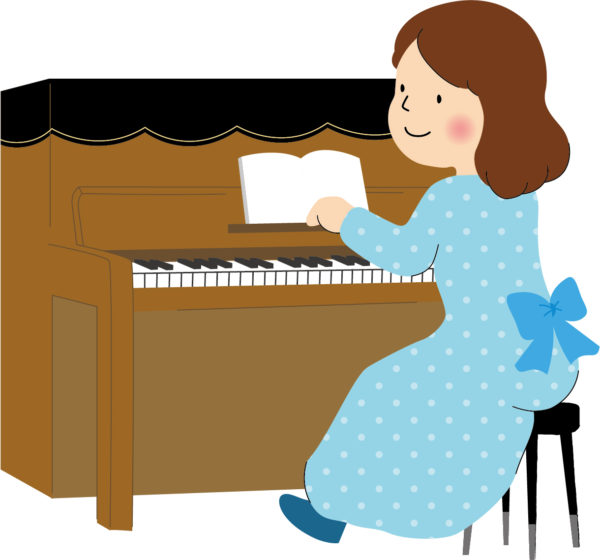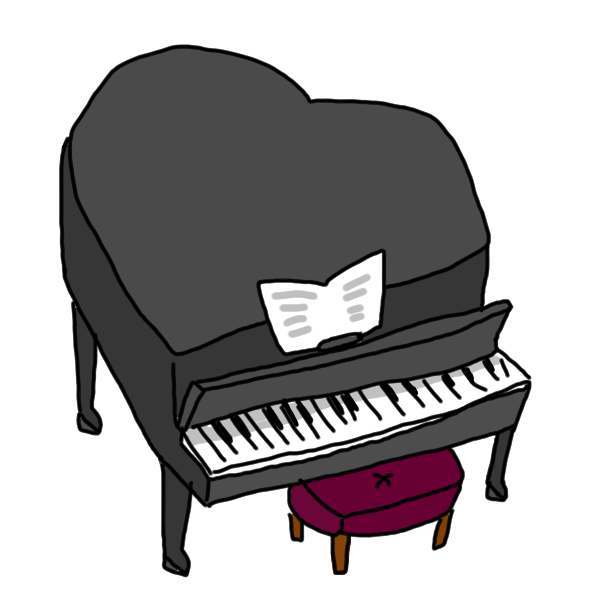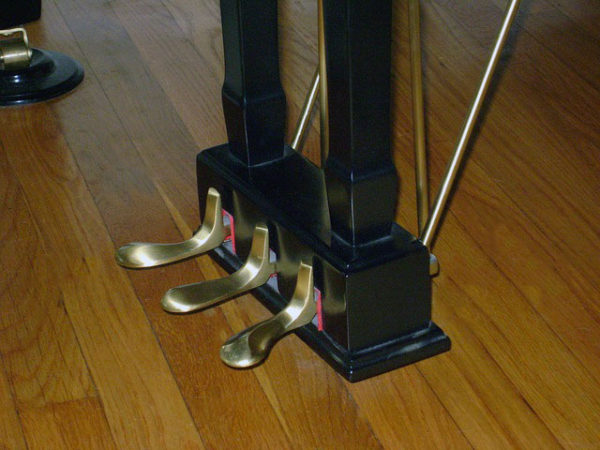
ピアノを始めた頃は鍵盤ばかりに目がいきがちで、足元のペダルのことは忘れてしまいます。
ピアノの教本を見ても、ペダルに関して詳しく記載しているものはあまり多くありません。
今回はピアノのペダルの名前と役割について説明していきます。
目次
ダンパーペダル

右側にあるペダルは「ダンパーペダル」といいます。
このペダルはピアノ内部のダンパーという部分を動かします。ダンパーは、ピアノの中の金属の弦に張り付いた薄いクッションです。ピアノの鍵盤を押すと、そのキーに付属している個々のクッションであるダンパーが上がり、弦が振動して音を出すことができます。指を鍵盤から離すと音が止まるのは、ダンパーが再び弦を押して、振動を止めるからなんです。
足でダンパーペダルを踏むと、すべてのダンパーが強制的に持ち上げられ、指を鍵盤から離しても音が鳴り続けます。
ダンパーペダルを使い、音を混ざり合わせて響かせることで美しい共鳴音を作り出すことができます。
ただし、一度に音が多すぎると音が濁り、聞いていて気持ちが悪くなることがあります。そのため、ダンパーペダル踏んだときは、一度に数音ずつだけ押さえて音色を完成させます。次のフレーズに移る前に、足を上げてダンパーを下げ、音を一度止めてクリアします。
自分のピアノの蓋を開けて、内部を覗いて、ダンパーペダルを踏んだり離したりしてみてください。
ダンパー機構の仕組みがよく分かると思います。
シフトペダル(ソフトペダル)

左側のペダルは「シフトペダル(ソフトペダル)」といいます。
実はグランドピアノとアップライトピアノでは少し名前が違っています。グランドピアノでは「シフトペダル」、アップライトピアノでは「ソフトペダル」といいます。少し役割が違うので、それぞれ分けて説明します。
グランドピアノのシフトペダル

シフトペダルはピアノの音を少し柔らかくします。
シフトペダルを踏むと、弦を響かせるハンマーをわずかに右側(高音側)にずらします。
あまり知らない人も多いかと思いますが、ピアノの鍵盤で鳴らされる弦は3本です。シフトペダルを踏んで鍵盤を押すことで、この弦の数を減らすことができるのです。
慣れていないうちは、その違いがよくわからないかもしれません。一番真ん中の「ド」でその違いをよく比べてみてください。
アップライトピアノのソフトペダル

アップライトピアノのソフトペダルは、音を弱く(ソフトに)します。
ソフトペダルを踏んでいる間は、弦を響かせるハンマーの初期位置を弦に近づけることができます。それにより、ハンマーは弦を激しく打つことができません。
つまり、鍵盤を強く押しても激しい音は出にくい状態になるのです。
ピアノを少しだけ静かにしたいときや、歌の伴奏として演奏するとき、朝の早い時間に練習しているときなどにソフトペダルを使うことができます。
ソステヌートペダル(マフラーペダル)

真ん中のペダルは「ソステヌートペダル(マフラーペダル)」といいます。
こちらも左側のペダルと同様に、グランドピアノとアップライトピアノでは名前が違っています。グランドピアノでは「ソステヌートペダル」、アップライトピアノでは「マフラーペダル」といいます。シフトペダルと違い、こちらは全く役割も使い方も違います。
グランドピアノのソステヌートペダル

ソステヌートペダルは特定の音だけを伸ばすことができます。
踏んだときに鍵盤の音を伸ばすことができるわけですが、ダンパーペダルとの違いは、「特定の音だけ」という点です。
ダンパーペダルは、鍵盤を押す前に踏んでも効果を発揮しますが、ソヌテートペダルの場合、鍵盤を押しているときに踏むことでその効果を発揮します。
ダンパーペダルと違い、伸ばしたい音を選ぶことができるため、目的に合わせて様々な演奏ができるのが特徴です。例えばアルペジオで根音となる鍵盤にソヌテートペダルを使うことで、その分散和音に深みをもたせることができるのです。
アップライトピアノのマフラーペダル

マフラーペダルはピアノの音全体を大幅に小さくします。
「マフラー」は車の排気口につけるものと同じ意味で、「消音」という意味です。襟巻きではありません。
マフラーペダルを踏むことで、ピアノの弦とハンマーの間に布が挟まります。それによりピアノの音を劇的に小さくすることができます。
当然音はすぐに消えてしまうため、本来の演奏で使うことはまずありません。
基本的にマフラーペダルは踏んだあとに左にスライドすることで固定できるように作られています。
あまり音が出せない時間などの環境に合わせて使うことで、周りに迷惑をかけずに練習することができます。
ペダルの踏み方

フットペダルを正しく踏む手順を説明します。
①ペダルに対して平行に右足が置ける位置を調整する。
車のアクセル・ブレーキペダルと同じく、ペダルに対して平行に足を置くことで、力を入れやすくなります。
②かかとをしっかりと地面につける
かかとを地面につけることで、かかとが支点となり、より力を均一にペダルにかけることができます。
もしかかとが浮いてしまうと、ペダルから離すときのタイミングが合わせにくくなってしまいます
③わずかに足先を上げる
ペダルを均一な力で踏むために足先をわずかに上げます。
自分の体重だけでペダルを踏もうとすると、バランスを崩し、鍵盤を弾く手に悪影響となることがあります。
なれるまでは意識して、踏む前に少しだけ浮かせるようにしましょう。
④母子球を使ってまっすぐペダルを踏む
ペダルに力をかけるところは、足の指先や土踏まずではなく、母子球と呼ばれる、足裏の親指の付け根にある丸い部分です。
このとき、速くペダルを踏んだり、力を入れすぎないように注意してください。
ペダルは踏んだあとに離します。力を入れすぎると、足を離しにくくなりスピーディーに動作ができなくなります。
⑤ゆっくりとペダルから離す
速くペダルから離れると、その振動が弦に伝わり、意図しない音が鳴ってしまうことがあります。
どんなにテンポが速い曲でも、ゆっくりと離すことを心がけましょう。
子供にペダルを踏ませるためには

幼い子供は足がペダルに届かず、無理にペダルをふもうとすると、バランスを崩し鍵盤を上手く弾けなくなってしまいます。
地面に足が着かない子供には、ペダルを踏ませる曲を練習させずに、足は補助台に載せることをおすすめします。
筋肉もまだ未熟なために、まずはスポットを鍵盤を弾く手だけに集中して、上達させたほうがいいからです。
どうしても子供にペダルを踏ませる曲を練習させたい場合は補助ペダルというものが便利です。
補助ペダルは、(正直あまり需要もないからか)高価なものが多いですが、いいペダルの代わりになるはずです。
お使いのピアノに対して合う合わないがありますので、購入の際は形やサイズなど、慎重に選ぶようにしましょう。

コメントを残す